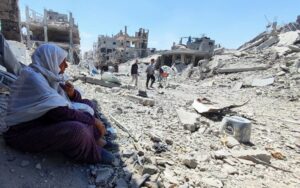Israel’s progression from apartheid to genocide

Palestinians return to their homes following the withdrawal of the Israeli army from the Jabalia area in northern Gaza where ground attacks continued for nearly three weeks, 31 May 2024
Yousef M. Aljamal writes in Mondoweiss on 7 June 2024:
For Palestinians, Israel’s violence began long before October 7, 2023. The unfolding genocide in Gaza is the latest chapter in a series of Israel’s settler-colonial practices to remove Palestinians by force from their land. These practices began with the inception of the state of Israel.
The most fateful year in modern Palestinian history was 1948, when David Ben-Gurion unilaterally declared the creation of the state of Israel and armed Zionist militias massacred Palestinians and evicted thousands from their homes at gunpoint. Palestinians know this as the Nakba, or “catastrophe.” This is not ancient history. Israeli politicians, before and after October 7, threatened a second Nakba against Palestinians. Israeli forces in Gaza painted graffiti on destroyed homes in Gaza that read, “Nakba 2023.”
Israel’s apartheid practices against Palestinians also started in 1948, when Israel caged Palestinian communities in Lod, Nazareth, and Haifa in wired areas and issued discriminatory laws against those Palestinians who stayed and those forcibly displaced. Soon after, Israel captured the Gaza Strip and the West Bank in 1967 and the discriminatory laws and practices were expanded to the occupied Palestinian territory.
At the time, Israel described the act of capturing what remained of historic Palestine in 1967 as “finishing the job.” The job was to ethnically cleanse the survivors of the Nakba and capture the territories left unoccupied in 1948.
Many Palestinians were displaced by war and were now under Israeli occupation in the West Bank, including East Jerusalem, and in the Gaza Strip where much of the Palestinian population sought refuge. The capture of Palestinians within the new Israeli State in 1948 and 1967 meant more than 811,000 Palestinians lived under occupation then, and with these two events, all Palestinians were now subject to Israel’s policies of apartheid.
Soon after Israel captured the Gaza Strip in 1967, for example, it introduced schemes to get rid of the young population of Gaza. In 1969, Moshe Dayan, Israel’s Defense Minister, introduced a plan to transfer young refugees in Gaza to Latin America. Between 1948 and 1967, Israeli army raids into Palestinian refugee camps of Rafah and Khan Younis killed hundreds of Palestinians, some of whom were stood against the famous Barquq Castle Wall and were killed, sometimes in front of their families.
Today the Barquq Castle itself is in ruins because of Israel’s destruction of Khan Younis.
Throughout the 1970s, Israel exploited Palestinian refugees as cheap labor to build Israeli settlements and with the outbreak of the 1987 Palestinian Intifada, and the mounting Israeli state and settler violence against Palestinians, apartheid practices and laws have only increased, suffocating Palestinians even more and making their lives almost impossible. This has been especially visible with travel restrictions, access to water, land and natural resources, and access to medical care.
The clearest manifestation of this permit regime, and the brutal realities of Israeli apartheid, has been seen in Gaza.
